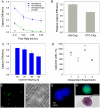Isolation of circulating tumor cells using a microvortex-generating herringbone-chip
- PMID: 20930119
- PMCID: PMC2972993
- DOI: 10.1073/pnas.1012539107
Isolation of circulating tumor cells using a microvortex-generating herringbone-chip
Abstract
Rare circulating tumor cells (CTCs) present in the bloodstream of patients with cancer provide a potentially accessible source for detection, characterization, and monitoring of nonhematological cancers. We previously demonstrated the effectiveness of a microfluidic device, the CTC-Chip, in capturing these epithelial cell adhesion molecule (EpCAM)-expressing cells using antibody-coated microposts. Here, we describe a high-throughput microfluidic mixing device, the herringbone-chip, or "HB-Chip," which provides an enhanced platform for CTC isolation. The HB-Chip design applies passive mixing of blood cells through the generation of microvortices to significantly increase the number of interactions between target CTCs and the antibody-coated chip surface. Efficient cell capture was validated using defined numbers of cancer cells spiked into control blood, and clinical utility was demonstrated in specimens from patients with prostate cancer. CTCs were detected in 14 of 15 (93%) patients with metastatic disease (median = 63 CTCs/mL, mean = 386 ± 238 CTCs/mL), and the tumor-specific TMPRSS2-ERG translocation was readily identified following RNA isolation and RT-PCR analysis. The use of transparent materials allowed for imaging of the captured CTCs using standard clinical histopathological stains, in addition to immunofluorescence-conjugated antibodies. In a subset of patient samples, the low shear design of the HB-Chip revealed microclusters of CTCs, previously unappreciated tumor cell aggregates that may contribute to the hematogenous dissemination of cancer.
Conflict of interest statement
The authors declare no conflict of interest.
Figures




References
-
- De Giorgi V, et al. Application of a filtration- and isolation-by-size technique for the detection of circulating tumor cells in cutaneous melanoma. J Invest Dermatol. 2010;130:2440–2447. - PubMed
-
- Fehm T, et al. Cytogenetic evidence that circulating epithelial cells in patients with carcinoma are malignant. Clin Cancer Res. 2002;8:2073–2084. - PubMed
-
- Moreno JG, et al. Changes in circulating carcinoma cells in patients with metastatic prostate cancer correlate with disease status. Urology. 2001;58:386–392. - PubMed
Publication types
MeSH terms
Substances
Grants and funding
LinkOut - more resources
Full Text Sources
Other Literature Sources
Medical
Miscellaneous

